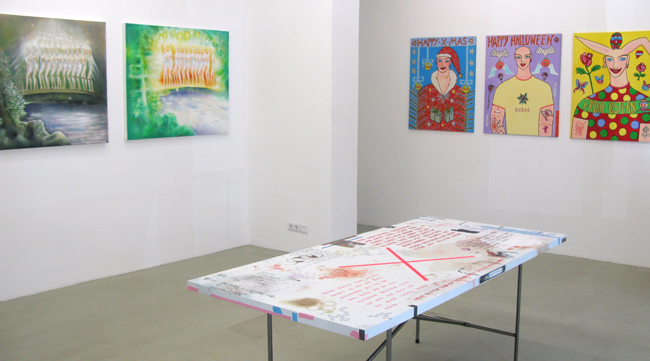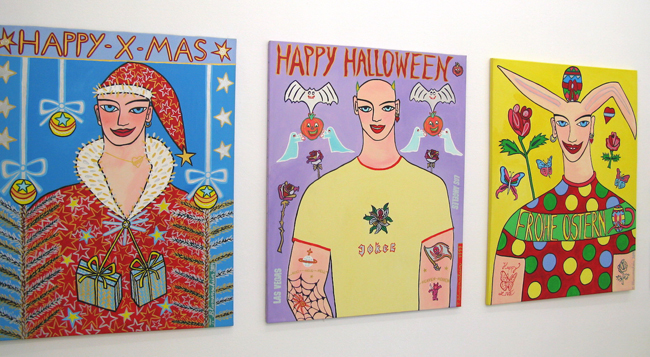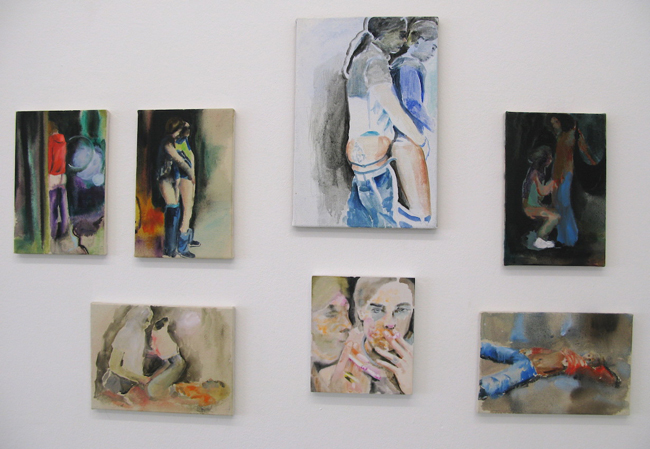| ZWINGER Galerie | |||||
|
| CURRENT |
| EXHIBITIONS |
| ARTISTS |
| LOCATION |
| IMPRINT |
| Wie wenn am Feiertage / If we took a holiday |
| Tabea Blumenschein, Kerstin Drechsel, Nancy Jones |
| Curated by Laurence A. Rickels |
| 18th July to 22nd August 2015 |
 |
| Wie wenn am Feiertage / If we took a holiday Blick in die Ausstellung |
Wie wenn am Feiertage/If we took a holiday Hölderlin’s Wie wenn am Feiertage extolls the vocation of the artist but by its incomplete status withholds confirmation of this calling. There is as yet a toll to pay. The artist runs up against a boundary in her source, her inspiration or Begeisterung. Heidegger highlights the Geister that are summoned within inspiration, which we can count, given Hölderlin’s abandonment of this work, as less spiritual and way more ghostly, in other words: more identifiable. What I take from Hölderlin’s work of incompletion, and transfer to the show featuring work by Tabea Blumenschein, Kerstin Drechsel, and Nancy Jones, is the ghostly wrap of the holiday, a family outing, in which mother (nature), father (god), and child (artist) jostle one another for precedence in time and memory. Hence rather than attempt to render in English the untranslatable title, the first line of Hölderlin’s poem, I cite instead a “matching” first line from Madonna’s Holiday. Hölderlin, too, personalizes the close quarters of nature, time, inspiration, and art via the myth of the birth of Bacchus. Semele bound her lover Zeus to grant her wish that she witness his divine glory. Her wish was fulfilled by the bolt that incinerated her. The fetal Bacchus survived Semele’s blasting and was carried to term sewn inside his father’s thigh. In adolescence Bacchus retrieved his mother from Hades: together they hosted the teen orgy cult organized around the fire water of inspiration. Her role was as Stimula (her name when in Rome), goading the cult members to find the affirmation in transgression. According to Hölderlin, the artist gives a form to the fateful bolt and bestows it on the public without the same risk. “Und daher trinken himmlisches Feuer jetzt/Die Erdensöhne ohne Gefahr.“ The artist mediates between the danger zone of inspiration and the happy inspiration to take “some time to celebrate, just one day out of life, it would be, it would be so nice.” The doubling back across the comma upon “it would be” echoes the coming of all the forces summoned by Hölderlin’s poem: “Des gemeinsamen Geistes Gedanken sind,/Still endend in der Seele des Dichters.” The highpoint of Heidegger’s reading follows: Mit Bedacht hat Hölderlin nach dem „sind“ ein Komma gesetzt. Wie ein unscheinbarer Meißelschlag des Bildhauers dem Gebilde ein anderes Gepräge verleiht, so legt dieses Komma ein eigenes Gewicht in das „sind“. Die „erwachende Natur“, die „Begeisterung“ ist gegenwärtig. Und die Art ihrer Gegenwart ist das Kommen. The comma Hölderlin and Madonna wield, and which Heidegger carries forward, applies, like the blow of the sculptor’s chisel, a weight/wait of its own. It also draws a curve, a drawing to be continued, turning the landscape into a body, a face. “You can turn this world around.” Unlike the bolt of the period at the end of a sentencing, the comma staggers wish fulfillment, turns the binding word around, and invites the Geister of inspiration, the identifiable ghosts of once and future holidays, to come and join in. It’s time for the good times |
| Laurence A. Rickels |
 |
| Wie wenn am Feiertage / If we took a holiday Tabea Blumenschein |
 |
| Wie wenn am Feiertage / If we took a holiday Kerstin Drechsel |
 |
| Wie wenn am Feiertage / If we took a holiday Nancy Jones |
| artist talk: | |
| Kerstin Drechsel: Saturday, 1st August, 6 pm | more |
| Nancy Jones: Saturday, 8th August, 6pm | more |
| Tabea Blumenschein: Saturday, 22nd August, 6 pm | more |